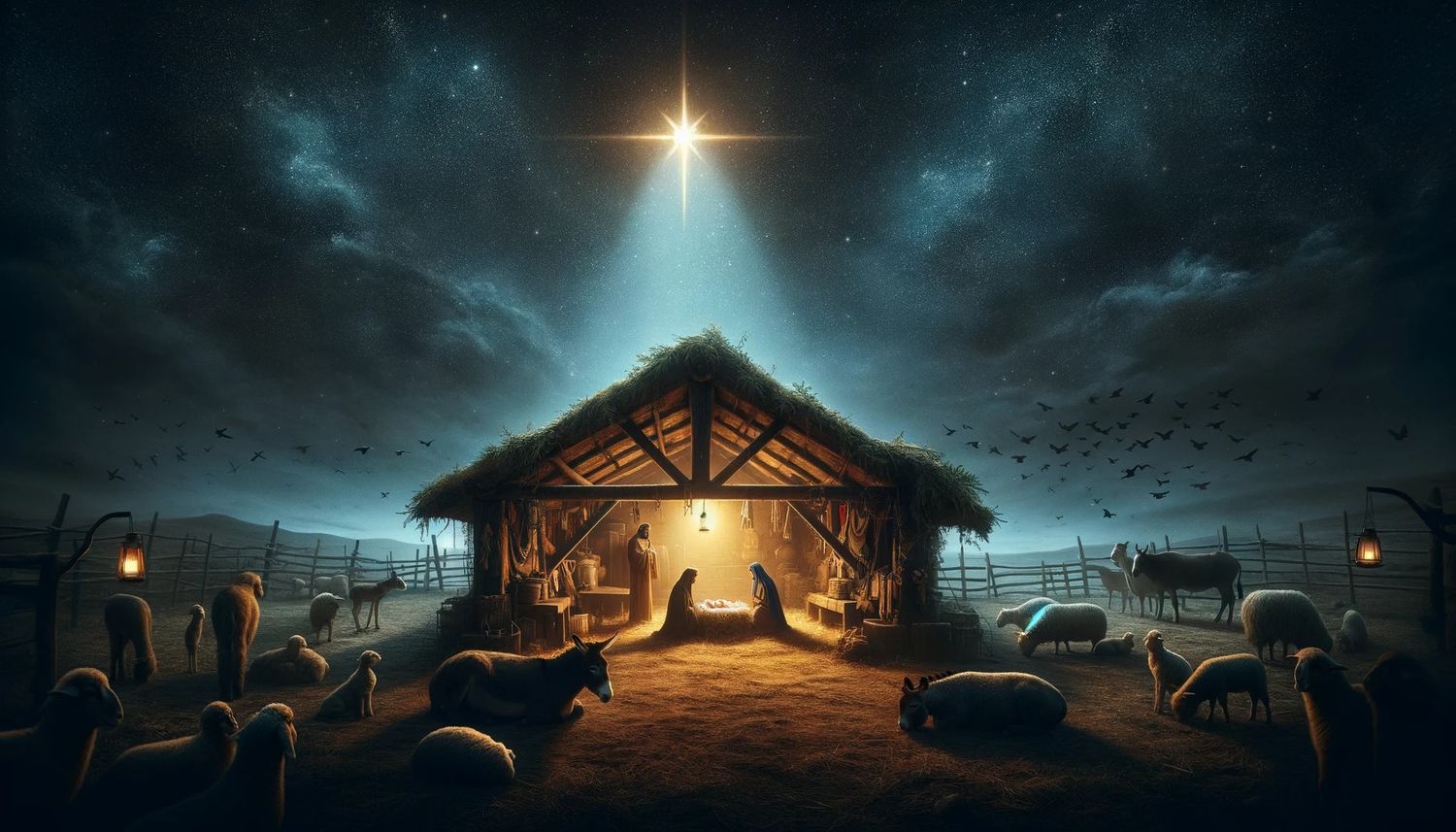Home>Christian Videos>Bible Stories>Which Gospels Tell The Christmas Story


Bible Stories
Which Gospels Tell The Christmas Story
Published: March 6, 2024
Ericka Andersen, an editor at Christian.net, expertly merges digital strategy with content creation, focusing on faith and societal issues. Her communication skills enhance the platform's engaging narratives, fostering meaningful dialogue on belief's impact on society.
Discover the Christmas story in the Bible with insights from the Gospels. Explore the significance of the birth of Jesus and the biblical narratives in the context of the holiday season. Uncover the timeless messages of hope and joy in these Bible stories.
(Many of the links in this article redirect to a specific reviewed product. Your purchase of these products through affiliate links helps to generate commission for Christian.net, at no extra cost. Learn more)
Table of Contents
Introduction
Which Gospels tell the Christmas story? The birth of Jesus Christ is a central event in the Christian faith, and it is recounted in the New Testament of the Bible. The Gospels of Matthew, Mark, Luke, and John each provide unique perspectives on the life and teachings of Jesus, including the events surrounding his birth. These accounts offer valuable insights into the significance of Christmas within the Christian tradition. Let's explore the distinct narratives presented in each Gospel and how they contribute to the rich tapestry of the Christmas story.
Read more: Parable Of The Sower: In Which Gospels?
The Gospel of Matthew's Account of the Christmas Story
-
Genealogy of Jesus: The Gospel of Matthew begins with a genealogy that traces Jesus' lineage back to King David and Abraham, emphasizing his royal and messianic heritage. This sets the stage for the significance of Jesus' birth within the context of Jewish expectations for a Messiah.
-
The Visit of the Magi: Matthew's Gospel uniquely features the visit of the Magi, or wise men, who come from the East to pay homage to the newborn King of the Jews. Their journey and the gifts they bring – gold, frankincense, and myrrh – symbolize the recognition of Jesus' royal status and his role as the Savior of all people, not just the Jews.
-
The Flight to Egypt: Following the Magi's visit, Joseph is warned in a dream to flee to Egypt with Mary and the infant Jesus to escape King Herod's plot to kill the child. This event fulfills the prophecy, "Out of Egypt I called my son," drawing a parallel between Jesus and the nation of Israel.
-
The Massacre of the Innocents: King Herod, realizing that the Magi had deceived him, orders the massacre of all male children in Bethlehem who are two years old and under. This tragic event underscores the political and spiritual opposition to Jesus' birth and foreshadows the challenges he will face in his ministry.
-
The Return to Nazareth: After Herod's death, Joseph, Mary, and Jesus return from Egypt and settle in Nazareth, fulfilling another prophecy that Jesus would be called a Nazarene. This relocation further emphasizes Jesus' identity as the fulfillment of Old Testament prophecies.
Matthew's account of the Christmas story highlights the themes of Jesus' royal lineage, the recognition of his universal significance, and the fulfillment of Old Testament prophecies. These elements contribute to the rich theological significance of Christmas as a celebration of the fulfillment of God's promises through the birth of Jesus Christ.
The Gospel of Luke's Account of the Christmas Story
-
The Annunciation: The Gospel of Luke begins with the angel Gabriel's visit to Mary, a virgin betrothed to Joseph. Gabriel announces to Mary that she will conceive and bear a son, who will be called the Son of the Most High. This miraculous conception through the Holy Spirit establishes the divine nature of Jesus' birth and his unique role as the Savior.
-
The Visitation: Following the Annunciation, Mary visits her relative Elizabeth, who is also miraculously pregnant with John the Baptist. When Mary greets Elizabeth, the baby in Elizabeth's womb leaps, and Elizabeth is filled with the Holy Spirit, recognizing Mary as the mother of her Lord. This encounter emphasizes the divine blessing upon Jesus' birth and foreshadows the interconnected destinies of Jesus and John the Baptist.
-
The Birth of Jesus: Luke's Gospel narrates the birth of Jesus in Bethlehem, where there was no room for them in the inn. This humble setting underscores the theme of Jesus' identification with the marginalized and the fulfillment of the prophecy that the Messiah would be born in Bethlehem.
-
The Shepherds and the Angels: An angel appears to shepherds in the fields, announcing the birth of the Savior. A multitude of heavenly hosts joins in praising God, proclaiming peace on earth and goodwill toward humanity. The shepherds then visit the manger and spread the news of the extraordinary events they have witnessed. This portrayal emphasizes the inclusive nature of Jesus' birth and the proclamation of good news to all people, regardless of social status.
-
The Presentation in the Temple: Mary and Joseph bring Jesus to the temple in Jerusalem to present him to the Lord, in accordance with Jewish law. They encounter Simeon and Anna, who recognize Jesus as the fulfillment of God's promises and speak prophetic words about his significance. This episode underscores the universal impact of Jesus' birth and the recognition of his role as the light of revelation to the Gentiles.
Luke's account of the Christmas story emphasizes the divine intervention in the conception and birth of Jesus, the inclusive nature of the Savior's arrival, and the recognition of his significance by both the marginalized and devout individuals. These elements contribute to the profound theological understanding of Christmas as the manifestation of God's redemptive plan through the birth of Jesus Christ.
The Gospel of John's Perspective on the Christmas Story
-
The Word Became Flesh: The Gospel of John presents a unique perspective on the Christmas story by introducing the concept of the Word becoming flesh. In the prologue, John describes the Word as being with God in the beginning and as the agent of creation. This theological framework emphasizes the divine nature of Jesus, who becomes incarnate to dwell among humanity. The concept of the Word becoming flesh underscores the profound significance of Jesus' birth as the embodiment of God's presence and redemptive purpose in the world.
-
The Testimony of John the Baptist: John's Gospel features the testimony of John the Baptist, who identifies Jesus as the Lamb of God who takes away the sin of the world. While John the Baptist does not narrate the infancy or birth of Jesus, his proclamation establishes the foundational understanding of Jesus' mission and identity. This testimony serves as a precursor to the unfolding revelation of Jesus' divine nature and redemptive role in the narrative of the Gospel.
-
The Light Shines in the Darkness: John's Gospel metaphorically portrays the arrival of Jesus as the light shining in the darkness. This imagery signifies the illuminating and transformative impact of Jesus' birth on the world. The contrast between light and darkness underscores the spiritual significance of Christmas as the dawn of God's redemptive work through the birth of Jesus, who brings hope and salvation to humanity.
-
The Incarnation and the Fulfillment of God's Plan: John's perspective on the Christmas story emphasizes the incarnation of the Word as the fulfillment of God's plan for the salvation of humanity. The divine initiative to enter into human existence through Jesus' birth underscores the depth of God's love and the restoration of the divine-human relationship. This theological emphasis highlights the eternal purpose behind the Christmas narrative and its implications for the reconciliation and renewal of creation.
-
Reception and Rejection of the Incarnate Word: John's Gospel portrays the reception and rejection of the incarnate Word by humanity. While some receive and believe in Jesus, others reject him, illustrating the polarizing impact of Jesus' birth and mission. This aspect of the narrative underscores the profound implications of Christmas for individuals and communities, inviting them to respond to the divine presence and purpose revealed in the birth of Jesus.
John's Gospel offers a profound and theological perspective on the Christmas story, emphasizing the divine nature of Jesus, the transformative impact of his birth, and the reception and rejection of the incarnate Word. This unique portrayal contributes to the multifaceted understanding of Christmas as the manifestation of God's redemptive plan through the birth of Jesus Christ.
The Gospel of Mark and the Christmas Story
The Gospel of Mark does not contain a narrative of the birth of Jesus or the events surrounding the first Christmas. Mark's Gospel begins with the ministry of John the Baptist and the baptism of Jesus, omitting any details related to Jesus' birth or infancy. This distinctive feature sets Mark's account apart from the other Gospels and has led to scholarly discussions about the absence of a traditional Christmas story in this Gospel.
Mark's Gospel focuses on presenting Jesus as the powerful and authoritative Son of God who inaugurates the kingdom of God through his teachings, miracles, and sacrificial death. The absence of a birth narrative aligns with Mark's emphasis on the adult ministry and mission of Jesus, highlighting the significance of his teachings and the establishment of the kingdom of God.
While the Gospel of Mark does not provide a direct account of the Christmas story, its portrayal of Jesus as the divine Son of God and the embodiment of God's redemptive purpose contributes to the broader theological understanding of the significance of Christmas. Mark's Gospel invites readers to encounter the transformative impact of Jesus' ministry and mission, emphasizing the eternal implications of his identity and redemptive work for humanity.
The absence of a traditional Christmas narrative in the Gospel of Mark underscores the diversity of perspectives within the New Testament and the multifaceted nature of the Christian faith. While the other Gospels offer detailed accounts of the events surrounding Jesus' birth, Mark's Gospel enriches the overall portrayal of Jesus' identity and mission, providing a unique lens through which to appreciate the profound significance of the Christmas story within the Christian tradition.















